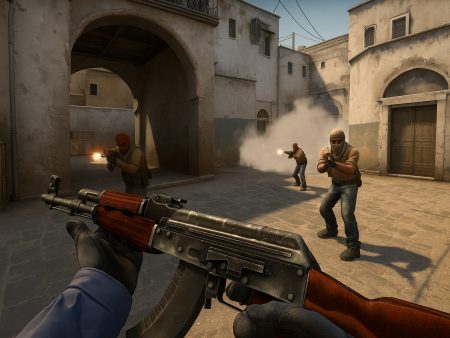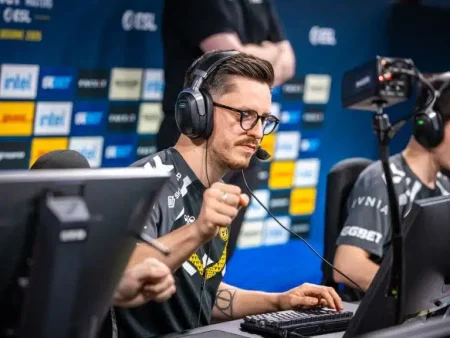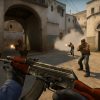Master CS2 angle advantage and peeking mechanics with this in-depth guide. Learn pro tactics, peeking styles, and win more gunfights today.
Welcome to the high-stakes world of Counter-Strike 2, where milliseconds and millimeters determine victory or death. If you’re wondering why you’re losing duels even when you’re holding the angle first, or why that one guy always seems to peek and delete you before you can blink—you’re in the right place. Mastering angle advantage and peeking mechanics in CS2 isn’t just a cool flex; it’s your ticket to climbing ranks, outsmarting opponents, and finally winning those clutch 1v3s.
In this guide, we’re breaking down everything: from the physics of peeking, to when to jiggle, and why some angles are dead traps. Whether you’re a weekend warrior or aiming for FPL, understanding how to use and counter angle mechanics in CS2 is essential. Let’s dive right in.
The Shift from CS:GO to CS2: What’s Changed
CS2 is more than just a graphical overhaul of CS:GO—it’s a fundamental change in how the game registers shots, handles movement, and most importantly, calculates player interactions in tight angles and fast peeks. The most significant shift? Sub-tick servers.
In CS:GO, gunfights were often dictated by the 64-tick (or 128-tick on FACEIT/ESEA) server logic. This tick rate defined how often the server updated player movements and actions. It led to infamous moments where shots felt like they should hit—but didn’t. Fast peekers could often abuse this desync to swing around corners and get the jump on defenders, which created a strong “peeker’s advantage.”
Enter CS2, and with it comes the Sub-tick Update System. It’s designed to log every input precisely, supposedly removing inconsistencies between what you see and what the server records. But does it really kill the peeker’s advantage? Not entirely. In fact, it has only changed how that advantage works—not eliminated it.
Server Tick Rate, Sub-tick Updates & Their Impact on Duels
Here’s where it gets spicy.
In CS2, Valve promises that every movement, every bullet fired, and every footstep is recorded the moment it happens—down to the sub-tick. But from a gameplay perspective, this introduces a new meta where timing, angle control, and server latency matter more than ever.
- Holding an angle? You might still die first if the opponent swings wide and shoots at the same moment they see you.
- Peeking? You need precise movement and sharp reaction speed. Sub-tick doesn’t mean your peek is invincible—it just means the server tracks your input more reliably.
- Lag? Still a factor. Even with sub-tick, 1-2 ms of difference can mean life or death.
In short: Sub-tick doesn’t remove peeker’s advantage. It just makes it more consistent—and more brutal if you don’t play it right.
What is Angle Advantage in CS2?

Defining Angle Advantage
“Angle Advantage” in CS2 is all about seeing your enemy before they see you, and positioning yourself so that your crosshair is already pre-aimed at where they’ll appear. It’s geometry meets muscle memory.
Imagine this: You’re holding an angle on Mirage A-site, watching Palace. The enemy swings out, and you’re already scoped in, crosshair on the pixel where their head should appear. That’s textbook angle advantage.
But wait—what if they wide-swing, and you still die first? That’s where the illusion of angle advantage kicks in, and you realize: it’s not just about holding. It’s about holding smartly.
How Angle Advantage Impacts Peeker’s and Holder’s Outcomes
Let’s get into the physics of it.
When holding an angle, your model is fully visible from the peeker’s POV before you even see them, due to how corner geometry works. Your screen might show only part of their body, but from their screen, they’re already seeing your whole upper torso. So even if you were technically “first” to spot them, their screen might register you earlier.
This is why crosshair placement, off-angle usage, and movement baiting become essential tools.
Peeker’s strengths:
- Can clear angles with control.
- Initiates the duel—momentum is on their side.
- Forces the defender to react, not act.
Holder’s strengths:
- Pre-aimed position.
- No movement penalty while standing still.
- Able to bait shots, shoulder peek.
In the end, it’s a tight dance—the one with the better angle and timing wins.
Examples of Good and Bad Angles in Competitive Play
Let’s use real examples:
Good Angle (CT Side): Holding Banana from Sandbags on Inferno. You see T’s feet first. You’re partially hidden. You’ve got cover to fall back.
Bad Angle (CT Side): Holding mid from top of mid in Dust2. You’re exposed to multiple swing points, no exit plan, and your crosshair needs to flick across multiple heights.
Good Angle (T Side): Peeking A Ramp from Tetris with a flash setup. Your head shows first, but you have time to strafe out, shoot, and fall back.
Bad Angle (T Side): Dry-peeking into AWP mid on Mirage. No flash, no info—just asking to be deleted.
Golden Rule? Always ask yourself: Can I fall back safely? Do I have cover? Who sees who first?
The Peeker’s Advantage – Fact or Fiction in CS2?
Netcode and Peek Timing: What Really Happens
Ah yes, the age-old argument—“Peeker’s Advantage.” It’s been a hot topic since the early CS:GO days and hasn’t gone anywhere with CS2. But here’s the truth: Peeker’s Advantage exists, and it’s deeply tied to netcode and peek timing mechanics.
To understand this, you have to realize that in any online game, what you see on your screen isn’t always exactly what’s happening on the server. Your computer talks to the server in small bursts (packets), and those packets arrive with delay—depending on your ping, tickrate, and now in CS2, the sub-tick update system.
When a player peeks a corner, the server might register them being visible slightly earlier for the peeker than the player holding the angle. That means the peeker can often see and shoot the opponent before the defender even sees them appear. It’s a subtle yet game-changing mechanic, and while CS2’s sub-tick system tries to reduce this, it’s still there.
Also, peeking with movement speed, or using counter-strafing to stop quickly, impacts how fast your bullets are accurate. If you peek and stop perfectly, your shot is deadly. If you’re sloppy, the defender wins. Timing and precision matter more than ever.
Real Peeker’s Advantage vs. Perceived Advantage
Let’s not confuse perception with reality. Sometimes, you die while holding a perfect angle and think, “No way he shot first.” But when you watch the demo or replay, you realize the peeker actually had a clean line of sight a few milliseconds before you even saw them.
This is real peeker’s advantage—a result of server-client sync and angle geometry. The perceived advantage, on the other hand, is what you believe you saw: dying behind cover, getting one-tapped “instantly,” or feeling like the game cheated you.
In CS2, both of these can occur, but sub-tick improvements have made real-time events more accurate. However, this accuracy also means duels happen faster and mistakes are punished more quickly. So it might feel like you’re dying faster than in CS:GO, but in reality, it’s just the game showing you exactly what happened—without delay.
Still, latency, peek width, and your own positioning contribute heavily. The more you expose yourself while holding an angle, the more likely a peeker will capitalize.
CS2’s Sub-tick System and How It Affects Peeking
Valve introduced sub-tick servers in CS2 to revolutionize how inputs are recorded and actions are resolved. The goal? Eliminate inconsistencies in movement and combat interactions by logging each player’s action the instant it happens—even between server ticks.
So, how does this affect peeking?
It makes movement feel smoother, and peeks more responsive. You might have noticed that wide-swinging now feels much more fluid than in CS:GO. There’s less jankiness. But this also means that reaction windows are tighter. You have less time to flick, less time to react—and peeking becomes deadlier in the hands of high-skill players.
In fact, CS2’s sub-tick system rewards clean movement. If you half-commit to a peek or mistime your strafe-stop, you’re toast. There’s no buffer anymore. And because the server registers your input the moment you click, peekers can actually shoot faster and more accurately, provided their movement is perfect.
On the flip side, if you’re holding an angle and waiting for a swing, you need to be laser-precise with your crosshair placement. You no longer have that millisecond delay that sometimes gave holders an edge. If you’re even a few pixels off, the fight’s over before you can adjust.
Mastering the Art of Peeking
Types of Peeks: Jiggle Peek, Shoulder Peek, Wide Peek, Dry Peek
Peeking isn’t just swinging a corner like a madman. In CS2, there are four primary types of peeks, each with its own purpose, timing, and effectiveness.
- Jiggle Peek – A quick left-right movement designed to gather info without fully exposing yourself. Great for baiting AWP shots or spotting a hold without committing.
- Shoulder Peek – Similar to jiggle peeking, but slightly wider and with the intention to draw a shot, especially from snipers or angle holders.
- Wide Peek – A full, committed peek where you swing wide past the corner. Best used when you suspect the enemy is pre-aiming a close angle. It throws off their crosshair placement.
- Dry Peek – A raw, unassisted peek with no utility support. This is risky, especially if you expect an AWP or multiple opponents watching the angle.
Each peek style has a time and place. Jiggle and shoulder peeks are great for baiting and gathering intel, while wide peeks are aggressive plays to break setups. Dry peeks? Use them only when you’re sure the enemy isn’t expecting you—or when time is running out and utility is gone.
When and How to Use Each Peeking Style
Let’s talk scenarios.
- Jiggle Peek: You’re on CT side Inferno B site. You jiggle from Coffins to see if someone’s pushing Banana. You’re not committing—you’re just trying to spot movement. Ideal for low-risk info plays.
- Shoulder Peek: You’re on T side Mirage, approaching A site. You shoulder peek jungle to bait an AWP shot, and when the shot comes, you swing with your rifle ready.
- Wide Peek: You’re in a 1v1, and the enemy is holding a tight angle. Instead of peeking with your head straight into their crosshair, you wide-swing and catch them mid-adjustment. Works wonders against passive AWPers or players known for pre-aiming.
- Dry Peek: You’re low on time. No smokes. No flashes. You have to clear Short on Dust2. You dry peek it and rely purely on crosshair placement and reaction time. High risk, high reward.
Understanding when to use each peek is a matter of intuition, map awareness, and reading the enemy’s habits. Pros mix up their peek styles constantly to stay unpredictable. You should too.
Common Peeking Mistakes and How to Avoid Them
Let’s face it—we’ve all messed up a peek and instantly regretted it. Whether it’s wide-swinging into an AWP with zero support or dry peeking two angles at once, here are the most common mistakes and how to fix them:
- Peeking Multiple Angles at Once
This is a death sentence. Always clear one angle at a time. If you’re peeking into mid and ramp simultaneously, you’re setting yourself up to get cross-fired. - Not Counter-strafing Properly
If you don’t stop cleanly after a strafe, your bullets will spray like a garden hose. Learn the timing to tap A/D, release, and shoot instantly. - Predictable Peeking Patterns
If you always peek the same way—same jiggle, same wide peek—you become readable. Mix up your timings, sometimes fake a peek, or change your speed. - No Crosshair Placement
If your crosshair is aimed at the ground or the wall before you peek, you’re done. Always pre-aim where the enemy’s head is likely to be. - Peeking Without Info or Utility
Dry-peeking a bombsite with no idea where the enemy is? That’s how you get deleted. Even a basic flashbang can turn a 50/50 duel into a win.
By avoiding these habits, you’ll win more duels, stay alive longer, and become that annoying player nobody wants to peek.
Holding Angles Like a Pro
Pre-aiming and Crosshair Placement
This is the cornerstone of CS2 gunfights. Pre-aiming means lining up your crosshair to the exact spot where you expect the enemy’s head to appear. Crosshair placement is keeping that crosshair at head level, tight to the edge of where a player might peek.
It sounds simple, but it’s where most players fall apart.
A good holder doesn’t wait with their crosshair in the middle of the screen. They anchor it tightly on corners. They track potential head heights as they move around the map. And when a peek comes, their mouse barely moves—they’re already aimed.
Want to improve? Watch pro players. They rarely flick. Their aim looks boring—because it’s already in the right place. That’s the magic of perfect crosshair placement.
Passive Hold vs. Aggressive Hold
Choosing between a passive or aggressive hold isn’t just a matter of playstyle—it’s a calculated decision based on round economy, team setup, enemy tendencies, and your own confidence. Understanding when and how to switch between these two approaches is crucial for staying unpredictable and maintaining control over the map.
Passive Holding is when you play further back, giving up some control but setting yourself up for safer engagements. Think of holding A site from CT spawn on Dust2, or anchoring B site from Coffins on Inferno. The benefits?
- You’re less likely to get caught off guard by early aggression.
- You can use sound cues to prepare your crosshair.
- You’re often positioned to fall back or rely on rotations.
But passive holds come with downsides. You give up early map control, allowing opponents to creep up or set up utility without contest. Against coordinated teams, this can let them execute onto sites with minimal resistance.
Aggressive Holding, on the other hand, is where you play closer to common push points—like peeking B apps on Mirage as CT or holding close Banana with a rifle on Inferno. This style gives you early information and potential first picks, which can shift the round in your favor. However, it’s risky:
- You’re exposed to flashes and utility.
- A bad peek can get you punished instantly.
- You might get isolated without a trade.
Top-tier players and teams often blend both approaches. Start aggressive for the surprise factor, then fall back into a passive hold after contact. Or hold passive early round, then re-aggress with a teammate and flash.
The real key? Adapting based on what the enemy is doing. If they’re consistently executing late, aggressive holds can net early picks. If they’re fast rushing, passive holds give you time to react. Smart players read these trends and position accordingly.
Adjusting Holds Based on Enemy Behavior
No two rounds are the same, and neither should your angle holds be. The best defenders are like chess players—they’re always a few moves ahead, reacting not just to what’s happening now, but to what’s likely coming next.
Let’s say you’re holding B site on Mirage and the Ts rush it three rounds in a row. You get overrun the first time. The second time you call for support, and it’s better. But by round three? You should be expecting that early aggression. Either fall back and molly apps to delay them, or pre-position with a teammate for a trade setup.
Now flip it. The Ts haven’t hit B for five rounds. This time, you might want to push for info, or hold a deeper off-angle expecting a late execute. Adjusting your hold isn’t just about guessing—it’s about pattern recognition.
Common behaviors to watch:
- Slow defaults? Play passive and force them to commit with utility.
- Fast executes? Play tighter angles with support nades.
- Lurks and flanks? Set traps with off-angles or tripwire positions.
The biggest mistake players make is holding the same angle the same way every round. That’s a recipe for getting pre-fired. The moment the enemy starts reading you, it’s time to change it up.
Advanced Mechanics for Angle Manipulation
Counter-strafing and Movement Precision
Counter-strafing is the secret sauce behind laser-accurate movement in CS2. If you’ve ever watched a pro peek a corner, shoot one bullet, and instantly stop dead in their tracks—you’re seeing perfect counter-strafe execution.
In CS2, like CS:GO, moving even slightly reduces your accuracy. Your bullets spread wildly unless you’re completely stationary. Counter-strafing is the act of stopping instantly after a strafe by pressing the opposite movement key. If you’re moving right with D, you tap A to stop. The faster and cleaner this input, the more precise your shot will be.
What’s changed in CS2 is how movement speed and the new sub-tick system affect timing. Now, inputs are read the moment they happen, which means if your counter-strafe is mistimed by even a few milliseconds, the server still punishes you. It’s all about muscle memory and rhythm.
To master this:
- Practice in 1v1 maps or DM servers with rifles.
- Focus on wide peeking and stopping just before you shoot.
- Use movement keys deliberately. Tap, don’t hold.
Clean movement isn’t just about shooting straight—it’s about presenting a smaller target, dodging pre-aims, and controlling how much of your body is exposed when clearing an angle.
Sound Cues and Timing in Peeks
CS2’s improved audio engine makes sound more important than ever. Footsteps, scoping, reloading, utility usage—it all feeds into your decision-making. A good player listens as much as they shoot.
When peeking, use audio cues to your advantage:
- Hear a reload? Swing instantly. You’ve got a free shot.
- Two sets of footsteps running together? Expect a trade setup.
- Silence? Might be a trap. Fake a shoulder peek to bait them out.
Timing is everything. If you peek too early, you might run into a molotov or flash. Too late, and they’ve repositioned. The sweet spot is just after a sound cue gives away their location. Peek when they throw a nade, scope in, or make noise falling off a ledge.
Also, be aware of your own sound. Jiggle peeking while walking is safer. Running gives you away. Walking into angles forces the enemy to react without knowing your position first.
Baiting Shots and Off-Angles
One of the sneakiest tools in your CS2 toolbox is the bait peek. Done right, it forces the enemy to shoot prematurely, giving away their position and letting you or a teammate clean them up.
Shoulder peeks are ideal for this. Show just enough of your model to trigger a reaction, then duck back and swing with intent. Pair this with a flash or a wide peek, and you’re golden.
Off-angles are another high-reward mechanic. Instead of holding the most common corner, play a weird spot. Maybe you’re crouched in front of a box instead of behind it. Maybe you’re elevated slightly on a slope where the enemy doesn’t pre-aim. These angles catch even high-skill players off guard, especially when they expect standard setups.
Off-angles work best when:
- The enemy is low on time and clearing fast.
- You’ve noticed a pattern in their peeking habits.
- You’re alone and need to surprise for a 1vX scenario.
But be careful—use off-angles sparingly. Once they’re discovered, they become liabilities.
Map-Specific Angle Mastery
Key Angles to Learn on Mirage, Inferno, and Dust2
Let’s talk practical application. Every map has power angles—spots that let you take early control, hold effectively, or shut down executes. If you want to master angle play, start with these three maps.
Mirage:
- A Ramp Tetris peek: Classic spot for Ts to dry peek CTs or swing default. Great for dry engagements, but risky against AWPs.
- Connector to Jungle: Tight angle with a high success rate if you hug the right side.
- Under Balcony on A site: A common off-angle that punishes aggressive jungle swings.
Inferno:
- Banana sandbags hold: You see feet first and have full cover—perfect for early round duels.
- Pit on A site: Gives long-range cover with control over both lane and site entries.
- CT Arch peeks: A solid spot to catch Ts rotating or pushing library.
Dust2:
- Long corner AWP peek: Peeker’s dream. Use flashes to win early control.
- Short ramp angle: Perfect for stopping late A pushes.
- Mid-to-B doors: Tricky angle that favors fast flicks and tight holds.
Memorizing angles isn’t just about where to stand—it’s about knowing when they’re strong. Early round? Mid-round rotations? Post-plant scenarios? Learn each angle’s purpose.
Smokes and Utility to Create Angle Control
Smokes, flashes, and molotovs are not just zoning tools—they’re angle manipulators. A single well-thrown smoke can deny vision, block a peeker’s line, or force an enemy to reposition into your crosshair.
Examples:
- Mirage Top Mid Smoke (T-side): Blocks off AWPer vision from Window and Connector, giving you freedom to peek or boost safely.
- Inferno CT Smoke (T-side B Push): Removes one key angle from defenders, letting you isolate coffins or new box.
- Dust2 Xbox Smoke: Classic setup for Short control without exposing yourself to Mid AWPs.
Flashes are even more powerful when paired with peeks. Throw a pop flash over a roof or corner just before swinging—it blinds holders instantly. Want to peek mid on Mirage? Get a teammate to bounce a flash off the wall. You peek right after. Clean, simple, deadly.
Molotovs can flush out common angles—forcing players off power spots like Sandbags, Dark, or Goose. Use them not just to kill, but to manipulate where your enemy can stand.
CS2 Utility and Its Impact on Peeking
Flash Timing and Setup Peeks
If you’ve ever wondered why you keep getting blinded mid-peek while your flashes seem to do nothing—this section is for you. Flashbangs are the unsung heroes of peeking. They turn a risky duel into a free kill when timed correctly.
Flash effectiveness in CS2 hinges on three things:
- Timing
- Trajectory
- Peeking synchronization
A well-timed flash is one that pops just before the player swings. If it pops too early, defenders can turn away. Too late, and you’re already dead before they’re blind. This is where setups with teammates shine. One player throws the flash while the other swings. It’s clean, safe, and incredibly effective.
Pop flashes, which explode instantly after bouncing off a wall or surface, are especially lethal. They give little to no warning and can blind defenders watching common angles.
Examples:
- Inferno B Pop Flash: Bounce it off the half-wall for instant Banana control.
- Mirage A Site Pop: Throw from Tetris to blind anyone holding CT or Default.
Solo flashing is possible too—self-pop setups like bouncing a flash off a wall and peeking behind it. It takes practice, but when mastered, it makes you a nightmare in 1v1s.
Tip: Practice with a friend in custom servers to get flash timings down. Perfect flash + perfect peek = free round.
Using Smokes for One-Ways and Gap Control
Smokes are more than visual blockers. In CS2, with the new dynamic smoke system, they become tools for controlling visibility, manipulating angles, and creating deadly one-way peeks.
One-way smokes are setups where you can see the enemy, but they can’t see you—until it’s too late. These are perfect for defenders looking to hold aggressive control, or for Ts holding post-plant positions.
Popular One-Ways:
- Mirage Window Smoke (CT side): Stand on bench and throw under the window to spot Mid.
- Inferno Balcony Smoke: Defenders can peek over it into short.
- Dust2 B Site Box Smoke: Offers a gap between double boxes and the wall.
Just as importantly, smokes cut off vision and allow safe movement. A well-placed smoke denies AWP sightlines, breaks up peeking angles, and lets you reposition or execute. The trick is to throw precisely. A bad smoke can leave gaps, giving the enemy the exact peek they need to shut you down.
And yes, gaps are real—players abuse smoke edges to peek with a pixel’s worth of vision. If you throw a smoke, know how the edges behave. CS2’s volumetric smoke makes this even more dynamic. A slight change in positioning affects the smoke’s flow.
Learn to throw:
- Lineup smokes (e.g., Top Mid, Xbox, Coffins)
- Gap smokes to bait pushes
- Post-plant smokes that let you play around the bomb
When used right, smokes don’t just obscure—they guide fights on your terms.
Practicing Angle Advantage in Aim Trainers and Custom Maps
Best CS2 Workshop Maps for Aim and Peeking Drills
You can’t just read your way to good aim or peeking mechanics—you need reps. Thankfully, the CS2 community is already pumping out great custom content to help you grind smarter.
Here are the must-use maps:
- Aim Botz – CS2 Version: Classic warm-up map. Customize target behavior, add peeking bots, and get your flicks tight.
- Yprac Maps (CS2-compatible): These include map-specific utilities, peeking scenarios, and real-time duel practice.
- Recoil Master CS2: Helps you perfect spray control. Essential when peeking and needing to track moving targets.
- Peek Training Maps: These simulate angles and real enemy peeks. Fantastic for learning when to shoot and how to adjust crosshair pre-aims.
When you use these maps:
- Start slow. Focus on accuracy, not speed.
- Work on entry duels by simulating common angles (e.g., Mirage connector hold, Inferno mid peek).
- Practice holding and counter-peeking for 10–15 minutes per day.
These drills translate directly into match performance. Over time, you’ll peek cleaner, shoot sharper, and win more fights simply by being prepared for the angle before it happens.
Drills to Sharpen Your Angle Awareness
Besides aim training, you should build muscle memory for angles. Your brain should know where to look—before your eyes see it. That’s how you get faster reactions and snappier headshots.
Here are drills that help:
- Pre-aim Pathing: Walk through maps in offline mode and practice pre-aiming every common angle in sequence.
- Angle Isolation Drills: Peek only one angle at a time. Force yourself to slow down and clear methodically.
- Flick Correction Training: Practice flicking from one angle to another—simulate when a second enemy appears after you kill the first.
- Deathmatch Angle Focus: Instead of just shooting anything, pick a spot on the map and hold it for a few minutes. Get used to peeking that angle perfectly.
Do these daily, and you’ll start to notice you’re not just reacting—you’re anticipating.
Pro Tips from the Best Players
How Pros Use Angles to Win Duels
Watch any top-tier CS2 match, and you’ll notice how pros play angles like chess—always three moves ahead. They’re not just holding or peeking randomly. They’re reading player behavior, baiting shots, and adjusting holds mid-round.
What separates the pros:
- Unpredictability: They never peek the same way twice. One round it’s a wide swing, next round it’s a shoulder bait.
- Intentional Off-Angles: They stand just a few pixels off where most players pre-aim, forcing flicks and missed shots.
- Time and Utility Usage: They wait for audio cues, use flash assists, and never dry peek unless they’re baiting info.
- Trade Positioning: Rarely do they peek alone. They peek with setups and have backups ready for trades.
Players like s1mple, ZywOo, m0NESY, and ropz are masters of angles. Their fights often look “unfair” because they’ve already calculated the best time and place to engage. Watching demos with x-ray on reveals how well they manipulate line-of-sight and timing.
Want to copy the pros? Start recording your own demos. Study what angles worked, what failed, and how your deaths happened. Every duel is a lesson.
Mind Games: Conditioning Opponents Through Peeking Patterns
Ever notice how your enemy suddenly pre-fires you after you peek the same angle three times? That’s no accident. You’ve been conditioned. And in CS2, psychology is half the battle.
Good players change patterns. They make you think they’ll peek wide—then shoulder. They bait info with jiggles—then walk into site when you look away. This is mind control through movement.
To condition your enemies:
- Repeat a safe peek twice, then switch it up with a wide swing the third time.
- Shoulder fake one side, then double-step and peek the opposite.
- Delay your peek timing from spawn so they mistime their crosshair placement.
On defense, you can do the same by playing a spot two rounds in a row, then disappearing the third. Make them waste utility or stare at empty corners.
Mind games are subtle, but over time, you’ll find you’re winning duels before the bullets are fired.
Conclusion
Mastering angles and peeking in CS2 isn’t a bonus—it’s the foundation of high-level play. Every duel, every round, every site take revolves around who controls the angle. Knowing when to peek, how to peek, and how to read your enemy’s angle habits separates the fraggers from the feeders.
We’ve covered it all—fundamentals, sub-tick mechanics, peek styles, holding strategies, utility usage, pro insights, and even training tips. But at the end of the day, what really matters is practice and adaptability.
CS2 is faster, cleaner, and more brutal than its predecessor. Angle advantage is no longer just about standing still and waiting—it’s about movement, mind games, precision, and timing. Train smart, play smarter, and you’ll turn those peeks into pixel-perfect highlight reels.
FAQs
What is the best peeking method in CS2?
The best method depends on the situation. Jiggle peeks are great for baiting shots, wide swings for surprising pre-aimers, and flash peeks for clean entries. Mixing them up keeps you unpredictable.
How do I counter peeker’s advantage in CS2?
Counter with smart holds, off-angles, and good crosshair placement. Don’t overcommit to wide swings without info. Use sound cues and utility to stall or bait the peeker into a bad duel.
Are there tools to train angle mechanics in CS2?
Yes! Use maps like Aim Botz, Yprac training maps, and Peek practice maps from the Steam Workshop. Combine these with daily deathmatch and pre-aim drills for best results.
What maps are best for learning angle control?
Start with Mirage, Inferno, and Dust2. These offer a variety of close and long-range angles and are commonly played. Each has classic spots for mastering both peeking and holding.
How do pros peek so fast and win duels?
They use clean movement, perfect crosshair placement, unpredictable timing, and utility support. Pros also read their opponent’s habits and punish predictable setups.












